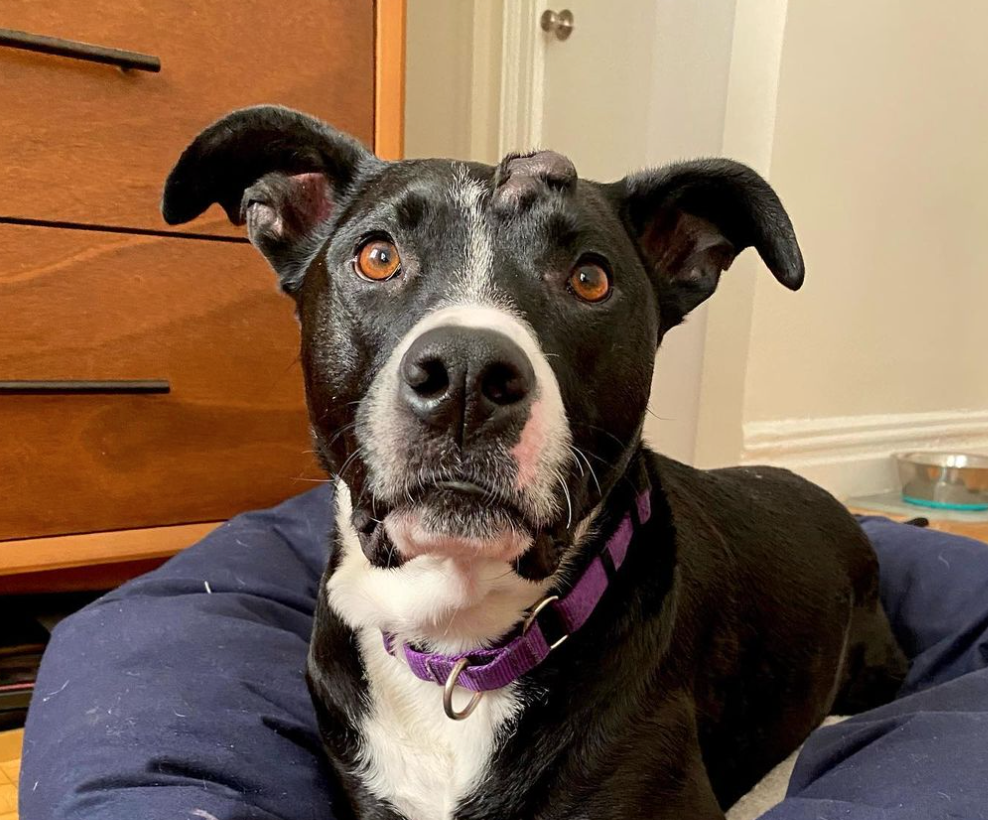Fostering With a Reactive Dog
Hi! I’m Haley, and this is my reactive dog, Mushu.
What does “reactive dog” mean? Well, it’s a dog who… you guessed it… reacts (usually in an undesirable way) to certain triggers! Was the first image that popped into your head the neighbor’s crazy dog who barks and lunges on walks? Or maybe your own dog? It’s okay, sometimes that’s what Mushu looks like, too…
But with some knowledge, training, management, and understanding of Mushu’s needs to keep all dogs and humans safe, he’s proven to be the ultimate foster brother. Despite his own reactivity, he’s shown 12 different dogs (ranging from 5lbs to 50lbs, puppies to seniors, and even some reactive foster siblings) better ways to express themselves. I’m going to share with you our secrets that keep everyone safe without compromising needs or happiness!
Reactive vs. Aggressive and Understanding the Reaction
The term “reactive” is commonly confused with “aggressive.” Though reactivity can lead to aggressive behaviors, they’re not the same! Reactivity is an exaggerated behavior that is triggered by a certain stimulant or situation. This could be a dog barking whenever they hear the doorbell ring, a dog running away or hiding when they hear a loud noise, or a dog lunging or barking at another dog on a walk. None of these behaviors would automatically result in aggression, but they definitely aren’t ideal.
So what causes reactivity? In most cases, reactive behaviors stem from fear! A dog is scared of who might be at the door, so they bark to alert everyone. A dog is scared of a firework, so they run and hide for protection. A dog is scared of another dog staring at them from across the street, and they may lung and bark because they think they have to protect themselves. Once you understand why the behavior is happening and what triggers your dog has, it’s a whole lot easier to help guide your dog to more acceptable behaviors!
Setting Your Reactive Foster Dog Up for Success: Management and Prevention
So where do you start when fostering with a reactive dog?
Step 1: Know your dog’s triggers!
Mushu does best with small dogs, so when I first signed up with Muddy Paws to foster, I asked for the smallest dog possible to get the best possible outcome! This alone was a huge help in gauging Mushu’s comfort to not push him over threshold and into a reactive mindset. Knowing where his comforts are helps to keep him from reacting!
Step 2: Plan ahead!
You’re approaching the day you bring home your foster, yay! What do you have to do to set up your home for this adjustment? For Mushu, it means setting up the foster’s crate before bringing the foster home (MPR can lend you a crate early). It also means picking up any toys or food sitting out and hiding them away where neither dog can get to them, placing extra water bowls around the apartment so they never fight over the same resource, and putting up a gate/barrier to the kitchen where all the food is stored to prevent the dogs from guarding it. Lastly, calling up a friend who can spend some time with you while picking up your foster and doing a slow introduction is a good idea. See tips here on slow dog intros!
Step 3: Have helpful tools ready!
In planning ahead, I also make sure I have a plan in place in case the dogs don’t get along right away. Fosters are usually pretty tired the first day they arrive. This is great because after an introduction on neutral ground, I can bring the dogs inside and plop the foster right into the crate for dinner and a nap. This gives Mushu time to observe the foster while they’re separated and gives the foster time to observe me, Mushu, and how this new environment operates. Anytime I can’t directly supervise Mushu and the foster, one of them is crated (commonly referred to as “crate and rotate” as you rotate which dog is crated and which can be roaming). This includes crating while I prepare their meals since Mushu typically resource guards his food. If Mushu doesn’t have the option of behaving inappropriately, he won’t be able to!
Because of Mushu’s size and strength, he is muzzled around fosters for at least the first few days, or until I can trust that everyone’s body language is relaxed. It’s one of the greatest tools we use to ensure safety! Muzzle training has also been a great tool for some of the reactive foster dogs Mushu and I have taken in to keep everyone safe both indoors and outdoors. See more about muzzling here!
While Mushu is muzzled, I also keep a leash on the foster dog (even indoors) while the pups learn to understand each other. We don’t know much about our fosters fresh off of transport, and the last thing I want to do is quickly grab at the foster’s collar if I need to redirect them away from Mushu or to create more space. I bet most people wouldn’t let some stranger quickly grab the collar of their shirt, no thanks! Keeping a leash dragging on the foster indoors is a safe way to guide them to make better decisions, and it creates more trust between Mushu and I if he knows I will redirect any foster—this way, he can stay within his comfort level, and he doesn’t have to react to stand up for himself.
Additional Support From the MPR Foster Team
The Muddy Paws Foster Team has the goal of setting every foster dog, resident dog, and foster parent up for success! We want fostering to be a fun and rewarding experience for everyone involved and work hard to make it as easy as possible. Not only can MPR provide any and all supplies needed, but we can also supply countless resources to fosters with information from blog posts, training guides, and training sessions for the foster dog.
In addition to the many resources we have at our fingertips and the incredible Foster Team staff, Muddy Paws Rescue has a Foster-Buddy System in place so that every foster parent is individually paired with a direct line of contact. Your volunteer-based foster-buddy will not only be available to answer any questions you may have, but they’re able to supply you with even more in depth resources, tips, tricks, and get you any additional help that your foster may require so that you feel completely supported throughout your lifesaving journey.
In the end, fostering with a reactive dog can definitely be challenging and take a little extra planning to make possible and do safely. But the reward is even greater (in my completely biased opinion) when you see your reactive pup learning, trusting, thriving, and overcoming some of their fears! Feel free to check us out at @mr_mushu_pork on Instagram to see more about our fostering journey.
And to start your own foster journey, sign up here!
Haley Wilson is a dedicated Muddy Paws foster, adopter, and volunteer.
Disclaimer: If you’re ever unsure if your dog can safely share their living space with another animal, please consult a certified trainer for guidance and feel free to reach out to Muddy Paws Rescue with any fostering related questions that we may be able to answer in order to get you started!






